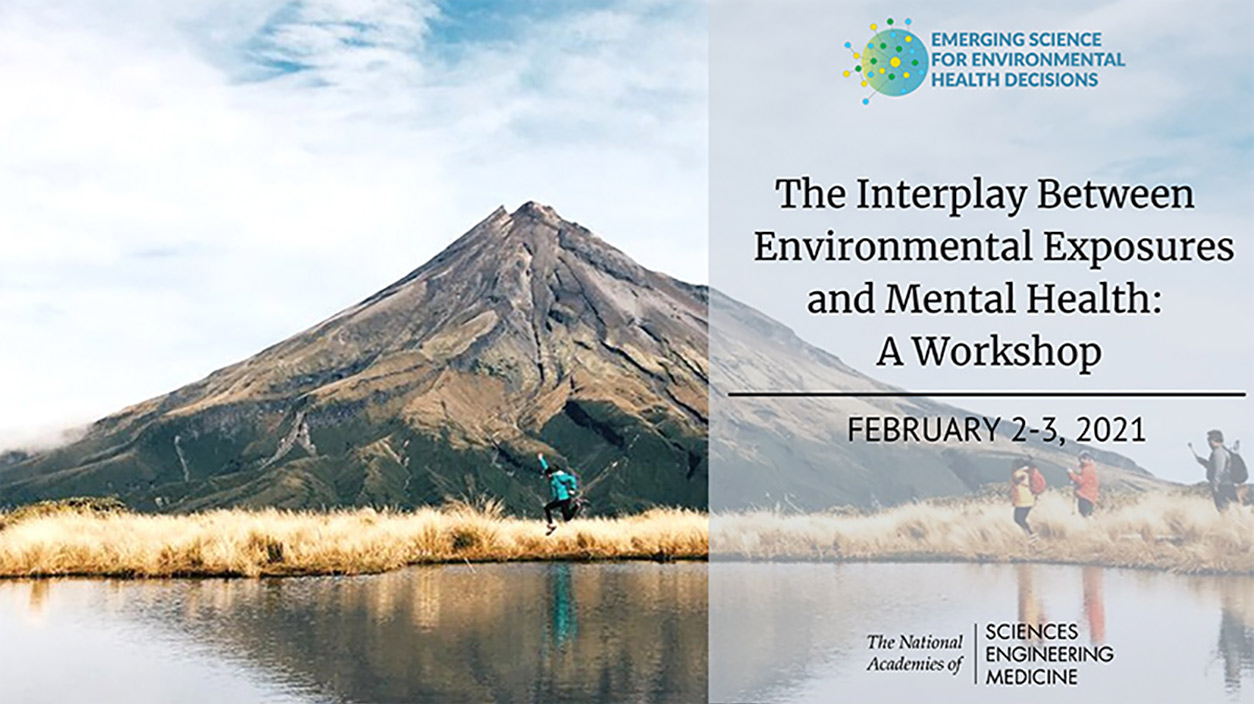
A National Academies workshop explored ways that the environment may present mental health risks or promote resilience.
There is growing evidence that the environment plays an important role in mental health. Yet, according to the National Academies of Sciences, Engineering, and Medicine (NASEM), research into the effects of environmental stressors rarely focuses on behavioral and mental health outcomes.
On Feb. 2-3, mental and environmental health researchers joined policy experts in a NASEM-sponsored workshop . Participants explored emerging science on relationships — both harmful and beneficial — between environmental exposures and mental health.

(Image courtesy of NASEM)
In his opening presentation (see video, right), Joshua Gordon, M.D., Ph.D. , director of the National Institute of Mental Health (NIMH), pointed out that environmental factors present both risk and protective influences on mental health. He grouped such factors into three types.

Gordon, shown here during his keynote address at an NIEHS workshop, joined NIMH in 2016. (Photo courtesy of Steve McCaw / NIEHS)
Gordon explained that the NIMH strategic plan calls for exploring mechanisms behind these influences. “We are interested in mechanistic relationships specifically because that allows us to build interventions that reduce risk and increase resilience,” he said.
The workshop planning committee, chaired by Gina Solomon, M.D. , from the University of California, San Francisco, organized the event around four topics.
NIEHS and National Toxicology Program Director Rick Woychik, Ph.D., in his opening remarks, looked to opportunities for more collaborative work between researchers.
Gary Miller, Ph.D. , an NIEHS grant recipient from Columbia University (see related article), said the workshop clearly demonstrated that scientists already know a lot about how we can improve mental health across a population by improving the environment. He emphasized the need for collaboration across disciplines — genomics, toxicology, psychology, psychiatry, and economics, to name a few — as well as with communities.
Decisions on local zoning codes, public housing architecture and green space, and infrastructure such as dams and highways can all affect mental health. “Unfortunately, this knowledge is not being transferred to these decisionmakers,” he said.
Evidence that the environment matters falls into three areas, according to keynote speaker Sandro Galea, M.D., Dr.P.H. , from the Boston University School of Public Health.

Galea stressed the need for innovative thinking. “Our methods often fall short,” he said, with respect to environmental pathogens, disruptions, and forms. (Photo courtesy of Sandro Galea)
According to Nora Volkow, M.D. , director of the National Institute on Drug Abuse, striking evidence for the importance of socioeconomic status in brain development underscores the need to study complex systems. She highlighted National Institutes of Health studies large enough to potentially reveal more about these connections.

Hollander organized an NIEHS workshop on psychiatric disorders and exposures, shown here at that event, and authored a review paper on the subject. (Photo courtesy of Steve McCaw / NIEHS)
Jonathan Hollander, Ph.D., from NIEHS, highlighted tools and technologies for assessing exposures that influence mental health. He discussed how exposures might be incorporated into mental health classifications.
Hollander oversees NIEHS grant funding for psychiatric disorders, neurodegenerative diseases, and neurodevelopmental toxicity, among others. See sidebar for his discussion of a current funding opportunity in mental and environmental health.
Citation: Reuben A, Schaefer JD, Moffitt TE, Broadbent J, Harrington H, Houts RM, Ramrakha S, Poulton R, Caspi A . 2019. Association of childhood lead exposure with adult personality traits and lifelong mental health. JAMA Psychiatry 76(4):418–425.
NIEHS research fundingHollander pointed to funding opportunities that directly support research discussed at the workshop.
Applications for a new grant program, Environmental Risks for Psychiatric Disorders, are due by Nov. 16, 2021. Hollander served as lead organizer of a 2017 NIEHS workshop on the topic.
He also noted that new interdisciplinary collaborations, much discussed at the workshop, are encouraged by an NIEHS program called the Virtual Consortium for Translational / Transdisciplinary Environmental Research (ViCTER). The next application deadline for this funding opportunity has not yet been announced.
“There’s no question that moving forward, we need to start breaking some of these silos between disciplines,” he said, referring to the fields of mental, psychiatric, and environmental health.
Hollander was lead author on a 2020 review of new data on the role of environmental chemicals in psychiatric conditions.
“The potential payoff for identifying environmental risk factors for psychiatric disorders is tremendous, as it affords a unique opportunity to not just modify symptom trajectory following diagnosis, but the possibility to prevent the development of the disease from the outset,” wrote Hollander and his co-authors.

Watch Woychik and Gordon’s presentations in this NASEM video of the workshop’s opening session. (20:36)
Primers lay groundworkThree video primers were shared prior to the workshop, to enhance discussions among participants from diverse fields.
Primer 1: Mental Health for Environmental Health Professionals by Erika Manczak, Ph.D., from the University of Denver. (23 minutes)
Primer 2: Environmental Health for Mental Health Professionals by Melissa Perry, Sc.D., from The George Washington University. (16 minutes)
Primer 3: The Role of Genetics in Mental and Behavioral Health Disorders by Daniel Geschwind, M.D., Ph.D., from the University of California, Los Angeles. (27 minutes)





Sign up for monthly newsletter updates
We will let you know when our newest issue is ready. Right in your email box!
The Environmental Factor is produced monthly by the National Institute of Environmental Health Sciences (NIEHS), Office of Communications and Public Liaison. The text is not copyrighted, and it can be reprinted without permission. If you use parts of Environmental Factor in your publication, we ask that you provide us with a copy for our records. We welcome your comments and suggestions.
Director of Communications: Christine Bruske Flowers | Editor-in-Chief: Caroline Stetler | Photo Editor: Joe Poccia